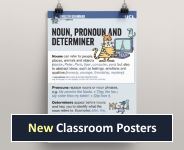Collective Nouns
Objective
To understand diffferent types of collective nouns.
Usually, nouns can be singular or plural, like book or books.
What other examples can you think of?
There are some nouns which only appear in the singular. Can you think of any?
Some nouns always mean 'more than one' and therefore they have no plural form, for example cups, saucers and plates can be described as crockery. Can you guess the word you could use to describe the nouns in the descriptions below?
- chickens, geese and ducks kept on a farm for their meat and eggs poultry
- objects like tables, chairs, beds, cupboards furniture
- cows and bulls kept as farm animals for their milk and meat cattle
There are also collective nouns. These are can be singular or plural, but they refer to a group of people or things.
Can you organise these collective nouns into two groups based on what groups they refer to?
Types of living beings
Some nouns are names for things that consist of two equal parts which are joined together. They only occur in a plural form. Can you sort these nouns into two groups and describe the kinds of nouns in each group?
The purpose of each item.
Some kinds of objects usually appear in small groups that are collected together. Read the sentences below and fill the gap with an appropriate collective noun. Click 'hint' to see some possible options.
- She arrived with a lovely _____ of flowers.
- When the police opened the suitcase, they found _____s of 100 Euro notes.
- I can't get into your room because of the _____s of dirty clothes!
- Time to go through the _____ of letters that have arrived.
- He decorated the cake with a ______ of berries.
- They brought ______s of firewood for the fire.
- All the books had been arrangaed in ______s, so that they could be put into boxes.
bunch, bundle, cluster, heap, pile, stack, wad
This lesson is adapted (with permission) from Words and Meanings: A Systematic Guide for the Teaching of English Vocabulary, by Gabriele Stein.
Welcome!

Englicious is totally free for everyone to use!
But in exchange, we ask that you register for an account on our site.
If you’ve already registered, you can log in straight away.
Since this is your first visit today, you can see this page by clicking the button below.
- Printer-friendly version
- Log in to view or leave comments

